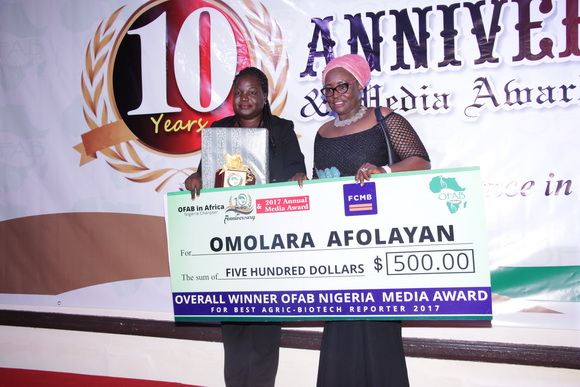
CROP BIOTECH UPDATE
---------------------------------------------------------------------------
A weekly summary of world developments in agri-biotech for developing countries, produced by the Global Knowledge Center on Crop Biotechnology, International Service for the Acquisition of Agri-biotech Applications SEAsiaCenter (ISAAA)
---------------------------------------------------------------------------
September 20, 2017
In This Week’s Issue:
News
Africa
OFAB Nigeria Recognizes Media for Effective Biotech Reporting
Uganda Harvests Another Successful GM Cassava Trial
Americas
Purdue Researchers Identify New Soybean Gene to Fight Phytophthora
Asia and the Pacific
Vietnam Encourages Use of GM Corn to Increase Productivity
FSANZ Calls for Submission on GM Canola Application
Brookes Presents Global Impact of Biotech Crops (1996-2015) to Indonesian Stakeholders
Filipino Farmers Await Bt Eggplant Commercialization
Research
Gene from Wild Grapevine Involved in Powdery Mildew Response in Transgenic Grapevine
MsmiR156 Promotes Root Development and Nitrogen Fixation Activity in Alfalfa
Cry1Ac in Tomato Confers Resistance to Tomato Leaf Miner
New Breeding Technologies
CRISPR-Cas9 Used to Analyze Cold Tolerance Related Transcription Factors in Rice
CRISPR Scissors Utilized to Break Yield Barrier in Crops
Beyond Crop Biotech
Scientists Sequence Apostasia Orchid Genome
Increased Expression of FSH Decreases Fecundity in Transgenic Female Pigs
----
NEWS
----
Africa
OFAB NIGERIA RECOGNIZES MEDIA FOR EFFECTIVE BIOTECH REPORTING
Open Forum on Agricultural Biotechnology (OFAB) Nigeria Chapter held a media award ceremony on August 30, 2017, at the Sheraton Hotels and Towers, Abuja, Nigeria. The event honors media practitioners and distinguished Nigerians who have contributed to raising awareness on biotechnology in the country.
The Chief Guest, Prof. Turner Isoun, Nigeria's former Minister of Science and Technology, said that Nigeria must give priority to funding research and development in order to achieve accelerated development. "No nation can make progress without paying adequate attention to research and development, our position as Africa's largest economy can be consolidated with research and development. We paid attention to science and technology during our stay in office and ten years after we have started seeing its contribution to the nation's GDP," he said.
According to OFAB-Nigeria Coordinator, Dr. Rose Gidado, the media is being celebrated as a result of their contribution to promoting biotechnology in Nigeria. "It is important to give honor to whom honor is due. The media have been our main ally since we set out to promote modern biotechnology in the country," she added.
In his keynote address, Dr. Tonnie Iredia, former Director General, Nigerian Television Authority (NTA), explained the role of science reporting in promoting national development. The panel of media practitioners and science reporters also addressed and suggested ways to improve science reporting in Nigeria.
Winners were drawn from television, radio, and print. An over-all winner for best agri-biotech reporting was also recognized, along with other key personalities that have played a fundamental role in shaping the biotechnology landscape in Nigeria. Former Nigeria President, Chief Olusegun Obasanjo was honored with the Grand Visionary Leadership award, while Prof. Turner Isoun, former Minister of Science and Technology and Prof. Ajayi Boroffice, Chairman, Senate Committee on Science and Technology, were honored for their contribution in setting the necessary foundation for biotechnology in Nigeria.
Know more about the OFAB Nigeria Success Story. For more information on the event, contact Dr. Rose Gidado on roxydado91@gmail.com
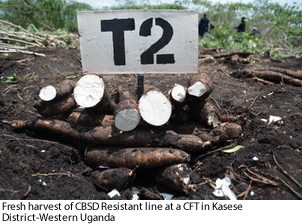
Uganda is one of the countries working towards eliminating the diseases through several projects including the Virus Resistant Cassava for Africa (VIRCA) Plus. The VIRCA Plus project is a collaborative effort involving the Donald Danforth Plant Science Center; the National Crops Resources Research Institute (NaCRRI) in Namulonge, Uganda; and the Kenya Agricultural and Livestock Research Organization (KALRO) in Nairobi, Kenya.
Using biotech tools, a farmer preferred variety (TME 204) was successfully transformed for resistance against CBSD. However, it did not have significant resistance against CMD. This called for conventional breeding to address the gap, since there are already farmer-preferred varieties that are resistant to CMD. The fourth confined field trial (CFT) was established with a goal to develop farmer-preferred varieties that are resistant to both diseases by crossing the transgenic lines (resistant to CBSD) and non-GM varieties (resistant to CMD). The trial also provided vital data for agronomic performance. VIRCA project has conducted several multilocational CFTs in Uganda and Kenya, the latest harvest being in Kasese district, western Uganda. Since 2010, NARO-Uganda has tested GM cassava with great progress.
For more information, contact UBIC at ubic.nacrri@gmail.com or visit the UBIC website.
Researchers from Purdue University and Dow AgroSciences have discovered a novel soybean gene that provides resistance to multiple types of Phytophthora sojae, the soil-borne pathogen causing soybean farmers in the U.S. to lose approximately $250 million per year due to soybean stem and root rot.
The researchers screened a wide variety of soybean genetic material and identified the gene Rps11 that confers strong resistance to Phytophthora sojae. The discovery will allow development of molecular markers so that the resistance gene could be rapidly incorporated into elite soybean varieties to help protect farmers' soybean yields against stem and root rot. Dow AgroSciences intends to make the technology broadly available to soybean farmers.
For more details, read the Purdue University Agriculture News.
Annually, Vietnam still has to spend a large amount of foreign currency to import corn seeds to serve the needs of animal feed processing in the country.
In 2016, Vietnam imported 8.3 million tons of maize. The Ministry of Agriculture and Rural Development (MARD) said that it would maintain the current area, but increase the value and output per unit of cultivated area, and encourage the adoption of new varieties, advanced farming methods, and accelerated mechanization.
The reasons for low productivity are unfavorable farming conditions and difficult terrain. The application of new varieties with resistance to unfavorable factors will improve the yield and quality of maize after harvesting. The introduction of genetically modified varieties into production in 2015 has initially been a positive signal, as corn yields and farmers incomes have improved remarkably. In 2016, the estimated area of transgenic maize accounted for about 10% of the total maize area in the country.
Read the original article in Vietnamese at SGGP online.
The Food Standards Australia New Zealand (FSANZ) has called for submissions on an application that seeks to allow food from a genetically modified (GM) canola line that produces an omega-3 fatty acid. The GM canola developed by the Commonwealth Scientific and Industrial Research Organisation (CSIRO) and Nuseed Pty Ltd) was modified to produce the long chain fatty acid docosahexaenoic acid (DHA) in the seed.
Mark Booth, FSANZ Chief Executive Officer said, "The applicant has stated that this canola line could provide an alternate source of DHA for food manufacturers in a range of products." He added that FSANZ has conducted a thorough safety assessment of the GM canola, which included a nutrition risk assessment and dietary exposure assessment, and has concluded there are no public health and safety concerns relating to this canola line.
Submissions will be accepted until October 26, 2017. For more details, read the FSANZ news release.
Over the last 20 years, crop biotechnology has significantly reduced agriculture's environmental impact and stimulated economic growth in the 26 countries where the technology is used. The innovative agricultural technology has contributed to preserving the earth's natural resources while allowing farmers to grow more, high quality crops. It has also helped alleviate poverty for 16.5 million, mostly smallholder farmers, in developing countries. This was forwarded by Graham Brookes, director of PG Economics, UK during a talkshow for media practitioners and seminar on September 11-12, 2017, at Arya Duta Hotel, Jakarta, Indonesia.
Brookes delivered a report on the Global Impact of Biotech Crops: Economic and Environmental Effects 1996-2015. He mentioned that in 2015, farmers in developing countries received $5.15 for each extra dollar invested in biotech crop seeds, whereas farmers in developed countries received $2.76 for each extra dollar invested in biotech crop seeds.
Ms. Ignatia Maria Honggowati of the Coordinating Ministry of Economy Affairs talked about the Roadmap on the Use and Development of Genetically Engineered Product; Prof. Dr. Bambang Purwantara of Indonesian Biotechnology Information Centre (IndoBIC) presented the Global Status of Commercialized Biotech/GM Crops: 2016; while Prof. Dr. Bustanul Arifin of Institute for Development of Economics and Finance (INDEF) and Centre for Strategic and International Studies (CSIS) delivered talks on Prospects of Biotechnology Products for Strengthening the Indonesian Economy; and The Role of Biotechnology to Support Indonesia's Food Security: Potential to Increase Corn Production.
Some 100 participants from the Ministry of Agriculture, the Coordinating Ministry Economy Affairs, Ministry of Environment and Forestry, Ministry of Trade, representative of Biosafety Commission and the Technical Team, media practitioners and private sectors attended the two-day event. The event was conducted by a collaborative effort between IndoBIC and The Coordinating Ministry of Economy Affairs with support from Croplife Indonesia, SEAMEO BIOTROP, and the International Services for the Acquisition of Agri-Biotech Applications (ISAAA).
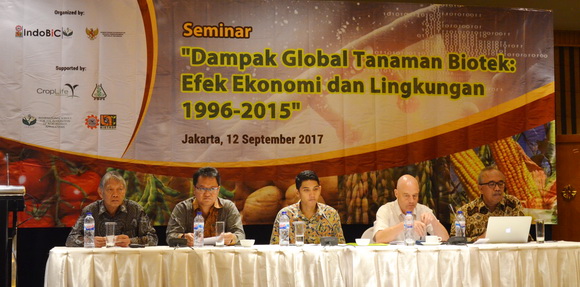
For more details, contact Dewi Suryani of IndoBIC at catleyavanda@gmail.com.
More than a hundred farmers and municipal agriculturists and technicians from the provinces of Pangasinan, Batangas, Quezon, and Davao in the Philippines expressed full support for the commercial planting of Bt eggplant. They hoped that the seeds be made available soon, after learning about its science, safety, and potential socioeconomic benefits during the Public Dialogue on Bt Eggplant held on September 14, 2017 at SEARCA Headquarters, College, Laguna. The activity served as a platform for farmers to clarify issues about the said technology.
Reynaldo Cueto, municipal agriculturist of Balete, Batangas said that his town is open for demo trials of Bt eggplant once it is commercialized, and he hopes that the crop can soon be planted by their farmers so that they can experience its benefits. Bt eggplant project leader, Dr. Desiree Hautea, said that University of the Philippines Los Baños (UPLB) welcomes feedback from the farmers regarding challenges in eggplant farming and other crops, and will continue to develop technologies to cater to their needs.
The other resource persons in the public dialogue were Bt eggplant study leaders and UPLB entomologists, Dr. Lourdes Taylo and Mr. Mario Navasero; and UPLB economics professor, Dr. Cesar Quicoy. The public dialogue was organized by ISAAA and SEARCA Biotechnology Information Center (SEARCA BIC).
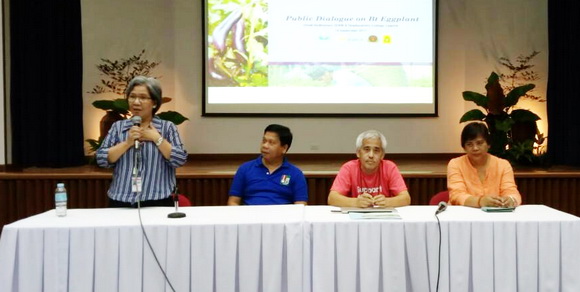
For more biotech updates in the Philippines, visit SEARCA BIC's website.
Ubiquitination plays important roles in disease resistance in plants. Lingmin Dai of Northwest A&F University in China identified and characterized the RING-type ubiquitin ligase gene, VpUR9, from the powdery mildew resistant Chinese wild grapevine (Vitis pseudoreticulata). The results are published in Plant Cell Tissue and Organ Culture.
The gene was found to be induced in response to powdery mildew disease and salicylic acid. VpUR9 gene was cloned and transformed into the powdery-mildew susceptible grape (Vitis vinifera L.) variety Red Globe. Twelve transgenic lines containing the gene were generated, but were found to be susceptible to powdery-mildew. Furthermore, the expression of some disease-resistant related genes of this variety also declined compared with wild type grapes when inoculated with powdery mildew or salicylic acid.
These results suggest that the VpUR9 gene may have negatively regulated the resistance of transgenic Red Globe to powdery mildew by changing the SA-dependent and the MeJA-dependent defense pathways.
For more on this study, read the article in Plant Cell Tissue and Organ Culture.
MicroRNA156 (miR156) regulates a network of genes that affect plant growth and development. Previous studies have generated alfalfa (Medicago sativa) plants that overexpress homologous miR156 (MsmiR156OE), which exhibited increased vegetative yield, delayed flowering, and longer roots. A team of scientists from the Agriculture and Agri-Food Canada led by Banyar Aung aimed to explain the effect of miR156 on the root system, including effect on nodulation and nitrogen fixation.
The team found that MsmiR156 overexpression increases root regeneration capacity in alfalfa, but with little effect on root biomass at the early stages of root development. MsmiR156 also promotes nitrogen fixation activity by upregulating expression of nitrogenase-related genes such as FixK, NifA, and RpoH in roots inoculated with Sinorrhizobium meliloti.
Further analysis of MsmiR156OE alfalfa roots identified differentially expressed genes belonging to different functional categories, including plant cell wall organization and response to water stress. Analysis also revealed the effects of miR156 on genes involved in nodulation, root development, and phytohormone biosynthesis.
These findings suggest that miR156 regulates root development and nitrogen fixation activity and thus it is vital in the improvement of alfalfa and other crops.
For more on this study, read the article in Transgenic Research.

Four transgenic lines expressing the Cry1Ac transgene were generated by the team. Expression of the Cry1Ac protein in tomato resulted in T. absoluta mortality rates ranging from 38100%. Moreover, it was found that a single copy of the gene in the hemizygous condition is sufficient to confer tolerance to the leaf miner.
This study could provide the foundation for developing transgenic commercial tomato cultivars resistant to leaf miner.
For more on this study, read the article in Plant Cell, Tissue and Organ Culture.
Rice (Oryza sativa) seedlings are sensitive to chilling. Hence, improvement of chilling tolerance in rice could increase rice quality and production. The team of Huang Xiao Zhen from Guizhou University in China isolated a transcription factor, TIFY1b, which could be involved in rice cold resistance. To explore the function of TIFY1b and its homologue, TIFY1a, CRISPR-Cas9 was used to edit their genome.
The rice cultivar Nipponbare was transformed using the CRISPR-Cas9 technique. Analysis of the T0 transgenic lines showed mutagenesis frequency ranging from 60% to 87.5%. These results suggest that CRISPR-Cas9 systems can effectively induce site-specific mutations in rice. Protein analysis showed that mutations caused function loss of TIFY1a or TIFY1b genes in T0 transgenic mutants. The mutations were also found to be inherited stably into the next generation.
A series of tify1 mutant lines were successfully obtained which would be used to investigate the role of TIFY1 genes in rice adaptation to chilling temperature. These studies might reveal a pathway that controls cold adaptation in rice and will help in the development of cold-tolerant rice cultivars.
For more on this study, read the article in Journal of Agricultural Biotechnology.
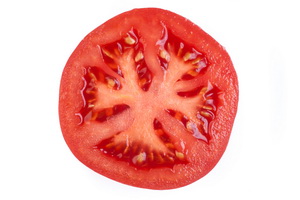 Scientists at Cold Spring Harbor Laboratory (CSHL) have tapped genome editing to improve agricultural crops. Using tomato as an example, they used CRISPR-Cas9 technology to rapidly generate variants of the plant that display a broad continuum of three separate, agriculturally important traits: fruit size, branching architecture, and overall plant shape -- components that determine plant yield. The method is designed to work in all food, feed, and fuel crops, including the staples rice, maize, sorghum, and wheat.
Scientists at Cold Spring Harbor Laboratory (CSHL) have tapped genome editing to improve agricultural crops. Using tomato as an example, they used CRISPR-Cas9 technology to rapidly generate variants of the plant that display a broad continuum of three separate, agriculturally important traits: fruit size, branching architecture, and overall plant shape -- components that determine plant yield. The method is designed to work in all food, feed, and fuel crops, including the staples rice, maize, sorghum, and wheat.
The team used CRISPR "scissors" to make multiple cuts within three tomato genome sequences known as promoters areas of DNA near associated genes which help regulate when, where, and at what level these "yield" genes are active during growth. The scientists were able to induce a wide range of changes in each of the three targeted traits.
By using CRISPR to mutate regulatory sequences, the CSHL team found that a much subtler impact on quantitative traits is possible. Fine-tuning gene expression rather than deleting or inactivating the proteins they encode is most likely to benefit commercial agriculture because of the flexibility such genetic variation provides for improving yield traits.
CSHL Professor Zachary Lippman, who led the research says, "Traditional breeding involves great time and effort to adapt beneficial variants of relevant genes to the best varieties, which must continuously be improved every year. Our approach can help bypass this constraint by directly generating and selecting for the most desirable variants controlling gene activity in the context of other natural mutations that benefit breeding. We can now work with the native DNA and enhance what nature has provided, which we believe can help break yield barriers."
For more details, read the CSHL News and Features.
An international team of researchers has sequenced the genome of the orchid Apostasia shenzhenica, an orchid type found in Southeast China. The researchers used 10x genomics scaffolding to conduct both short and long-read sequencing to develop a genome sequence of the plant. They also used the results of their work to compare the plant with other orchids in order to isolate parts that were the same versus those that were different using transcriptome data.
The research team found that A. shenzhenica belongs to the family of orchids, and that large parts of the genome were virtual copies of those of other orchid types. They also found that it split off from other orchids millions of years ago, close to the time when orchids first came to exist. It was also found that orchids underwent a major extinction period after which the plants differentiated and subsequently evolved into five subfamilies. The researchers suggest that it was during this period that features such as the famous "lip" developed.
More details are available in the open access paper in Nature.
Follicle-stimulating hormone (FSH) regulates reproduction in mammals. Overexpression of the exogenous FSHα/β genes from Chinese Erhualian pigs improved female fertility of transgenic mice and male spermatogenesis ability of transgenic Large White boars. The team of Kai Jiang of Jiangxi Agricultural University in China investigated the impact of the exogenous FSHα/β genes on female reproductive performance of Large White pigs.
The transgenic gilts showed higher levels of serum FSH and FSHβ protein in their pituitary. The transgenic gilts were healthy and grew normally without significant differences as compared to wild types. However, these transgenics had lower number of born piglets than their wild type half sibs. The expression levels of FSHR, LHR, ESR1, and ESR2 were also significantly lower in the transgenics than in wild type gilts at the age of 300 days.
This study found that overexpressed FSHα/β transgenes could cause deterioration in fertility of female Large White pigs disturbing the expression of the endogenous reproduction-related genes in female pigs.
For more on this study, read the article in Transgenic Research.